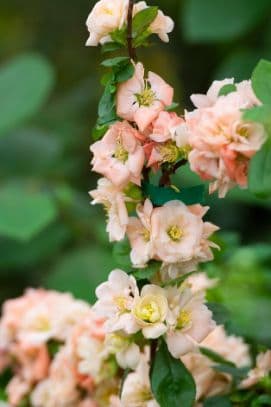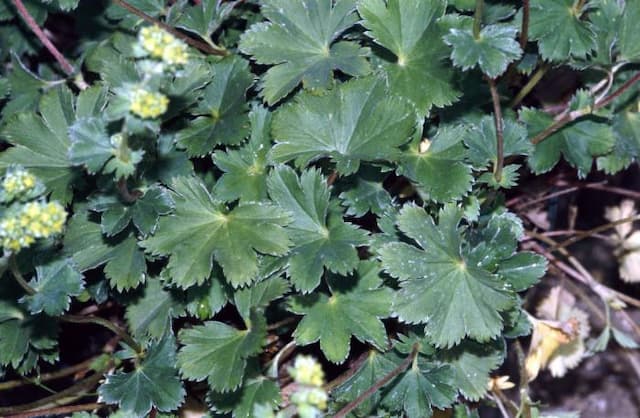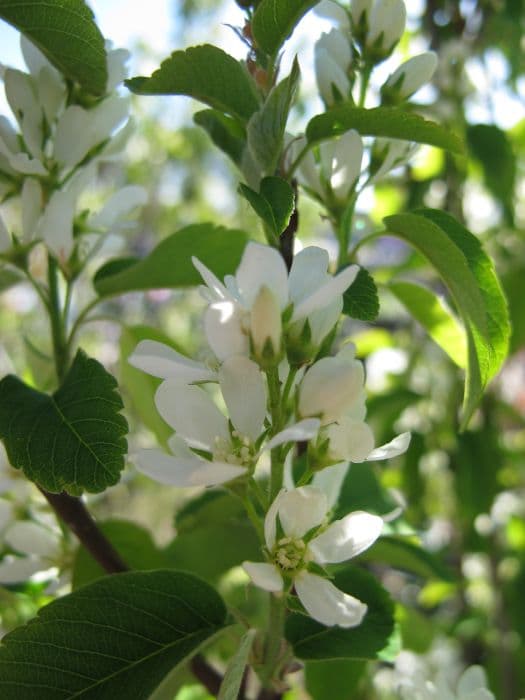Flowering Quince Chaenomeles speciosa 'Geisha Girl' (d)

ABOUT
The Chaenomeles speciosa 'Geisha Girl', commonly known as Flowering Quince 'Geisha Girl', is a deciduous shrub recognized for its showy floral display. The plant is adorned with attractive double flowers that have a delicate pinkish-orange hue, creating an eye-catching burst of color in the early spring, often before the leaves fully emerge. These blossoms offer an exquisite beauty with their layered petals forming a rose-like appearance, contributing to the plant's ornamental charm. Leaves of the Flowering Quince 'Geisha Girl' are glossy and dark green, turning to a striking display of oranges and reds before falling in the autumn. The foliage is oval-shaped with a slightly serrated edge framing each leaf, giving them a textured and dynamic outline. Additionally, the plant may produce small fruits, resembling miniature quinces, that can add further interest later in the season. These fruits are aromatic and can occasionally be used for culinary purposes, although they are not the primary reason gardeners choose this plant. The overall aesthetic of the Flowering Quince 'Geisha Girl' is one of a vibrant and robust shrub with an early bloom time, providing an enchanting addition to the garden landscape during a time when many other plants have yet to awaken from winter dormancy.
About this plant
 Names
NamesFamily
Rosaceae.
Synonyms
Flowering Quince, Japanese Quince, Geisha Girl.
Common names
Chaenomeles lagenaria 'Geisha Girl', Cydonia speciosa 'Geisha Girl'
 Toxicity
ToxicityTo humans
The Flowering Quince is not known to be toxic to humans. There are no common reports of poisoning upon ingestion of this plant.
To pets
The Flowering Quince is not considered highly toxic to pets. However, if a pet ingests a large amount of the plant, they may experience mild gastrointestinal upset, such as vomiting or diarrhea. It is always best to prevent pets from eating ornamental plants as a precaution.
 Characteristics
CharacteristicsLife cycle
Perennials
Foliage type
Deciduous
Color of leaves
Green
Flower color
Pink
Height
4-5 feet (1.2-1.5 meters)
Spread
4-5 feet (1.2-1.5 meters)
Plant type
Shrub
Hardiness zones
5
Native area
China
Benefits
 General Benefits
General Benefits- Ornamental Appeal: Chaenomeles speciosa 'Geisha Girl', commonly known as Flowering Quince, has vibrant orange-pink flowers that add aesthetic value to landscapes and gardens.
- Wildlife Attraction: The plant's flowers provide nectar to pollinators, while its fruit can attract birds and other wildlife.
- Low Maintenance: Flowering Quince is known for its hardiness and can thrive with minimal care once established, making it suitable for gardeners of all skill levels.
- Drought Tolerance: Once established, it is relatively drought-tolerant, reducing the need for frequent watering.
- Erosion Control: Its dense growth habit can help stabilize soil and prevent erosion on slopes and banks.
- Privacy and Barrier: With its thorny branches, Flowering Quince can be used as a protective hedge, creating a natural barrier or privacy screen.
- Adaptability: It is adaptable to a wide range of soil types, though it prefers well-drained soils.
- Seasonal Interest: Flowering Quince provides year-round interest with flowers in spring, lush foliage in summer, and sometimes fruit in autumn or winter.
- Compact Growth: As a cultivar with a more compact habit, it is suitable for smaller gardens or spaces where a full-sized quince would be too large.
- Cultural Significance: In some cultures, the Flowering Quince is a symbol of good luck and prosperity, and it is often used in celebratory events.
 Medical Properties
Medical Properties- Anti-inflammatory: The fruit of the flowering quince has been used in traditional medicine to reduce inflammation.
- Antioxidant: Extracts from the fruit are known to contain high levels of antioxidants, which are beneficial for neutralizing harmful free radicals in the body.
- Antiviral: Compounds in the flowering quince have demonstrated antiviral properties in some studies.
- Antibacterial: The fruit and seed extracts might show antibacterial effects against certain strains of bacteria.
- Immune system support: The high vitamin C content found in the fruits is thought to support the immune system.
 Air-purifying Qualities
Air-purifying QualitiesThis plant is not specifically known for air purifying qualities.
 Other Uses
Other Uses- Flowering Quince 'Geisha Girl' branches can be used in floral arrangements to provide a bright splash of color and an interesting texture, enhancing the aesthetic appeal of indoor decor.
- The dense thorny branches of Flowering Quince 'Geisha Girl' can be utilized as a natural barrier or hedge to deter animals or unwelcome visitors from entering a specific area.
- In bonsai culture, the Flowering Quince 'Geisha Girl' is admired for its beautiful blossoms and can be trained for ornamental purposes in miniature landscapes.
- The fruits of Flowering Quince 'Geisha Girl' may be used in the preparation of marmalades, jellies, and preserves, providing a unique tart flavor.
- As a subject for photography, the vibrant flowers and unique form of Flowering Quince 'Geisha Girl' can be captured to create stunning botanical art and to practice close-up flower photography skills.
- The plant's wood, being hard and dense, may be harvested and used for crafting small items, such as tool handles or intricately carved ornaments.
- Flowering Quince 'Geisha Girl' can be planted to attract pollinators like bees and butterflies, enhancing the biodiversity of a garden space.
- The blossoms may be floated in bowls of water to create simple and elegant centerpieces for events or home decoration.
- When trained against a wall or fence, Flowering Quince 'Geisha Girl' can be used as an ornamental espalier, showcasing its blooms in the springtime.
- The fallen petals of Flowering Quince 'Geisha Girl' can be collected and used as a natural confetti for outdoor celebrations or ceremonies.
Interesting Facts
 Feng Shui
Feng ShuiThe Flowering Quince is not used in Feng Shui practice.
 Zodiac Sign Compitability
Zodiac Sign CompitabilityThe Flowering Quince is not used in astrology practice.
 Plant Symbolism
Plant Symbolism- Resilience: Chaenomeles speciosa, commonly known as flowering quince, is a hardy plant that withstands tough conditions, symbolizing the ability to persevere and thrive through challenges.
- Beauty: The 'Geisha Girl' cultivar, with its delicate, ornamental flowers, represents beauty and elegance.
- Protection: The thorny branches of the flowering quince are often associated with protection and the safeguarding of loved ones.
- Renewal: As one of the first plants to bloom in late winter or early spring, the flowering quince is a symbol of new beginnings and the renewal of life.
- Love and Fertility: Its early spring blossoms, which can also represent love and fertility, make it a fitting symbol for growth and the potential for new life.
 Water
WaterFlowering quince 'Geisha Girl' should be watered deeply to ensure that the water reaches the roots, particularly during dry spells. Established plants typically require watering every 7 to 10 days during the growing season, with about 1 to 1.5 gallons per plant per watering session, depending on the weather conditions. During the winter months, watering can be reduced as the plant's water requirements decrease. It's important to avoid overwatering, which can lead to root rot. Ensure that the soil around the plant is moist but not waterlogged.
 Light
LightFlowering quince 'Geisha Girl' thrives in full sun to partial shade. The best spot for planting is where the plant can receive at least 6 hours of direct sunlight each day while being protected from the harsh afternoon sun if the climate is particularly hot. Dappled sunlight works well for this plant, especially in regions with very hot summers.
 Temperature
TemperatureFlowering quince 'Geisha Girl' is hardy and can tolerate a wide range of temperatures. It can survive winter temperatures as low as 0°F but prefers the temperature to be above 20°F to avoid damage to the buds and flowers. The ideal temperature for optimal growth and flowering is between 60°F and 80°F.
 Pruning
PruningPrune flowering quince 'Geisha Girl' to maintain its shape, remove any dead or diseased wood, and encourage flowering. The best time for pruning is immediately after the plant has finished blooming in late spring. Light pruning can be done annually, with more substantial pruning every 2 to 3 years to rejuvenate older plants.
 Cleaning
CleaningAs needed
 Soil
SoilFlowering quince 'Geisha Girl' thrives in fertile, well-draining soil with ample organic matter. A soil mix containing equal parts loam, peat, and sand or perlite creates optimal growing conditions. This cultivar prefers a slightly acidic to neutral pH, ranging from 6.0 to 7.0, which allows for robust growth and flowering.
 Repotting
RepottingThe flowering quince 'Geisha Girl' typically requires repotting every 2 to 3 years. Repotting is best done in late winter or early spring, before new growth begins, to minimize stress and encourage healthy development during the growing season.
 Humidity & Misting
Humidity & MistingFlowering quince 'Geisha Girl' is adaptable to various humidity levels and does not require specific humidity conditions to thrive. It performs well in the ambient outdoor humidity in most temperate climates.
 Suitable locations
Suitable locationsIndoor
Place in bright, indirect light and keep room temp.
Outdoor
Full sun to partial shade, shield from strong winds.
Hardiness zone
5-9 USDA
 Life cycle
Life cycleChaenomeles speciosa 'Geisha Girl', commonly known as Flowering Quince, begins its life cycle when a seed germinates in favorable soil conditions. After germination, the seedling emerges and enters the vegetative growth phase, where it develops roots, stems, and leaves. As the plant matures, it enters the flowering stage, typically in early spring, displaying vibrant, ornamental flowers. Following pollination, which can be assisted by insects, the flowers develop into fruit, a pome, which contains seeds for the next generation. The plant then enters a period of dormancy, often in response to colder temperatures in the fall or winter. During the next growing season, the Flowering Quince resumes growth from existing stems and completes the life cycle annually through similar phases of growth, flowering, and dormancy.
 Propogation
PropogationPropogation time
Spring-Early Summer
The Flowering Quince 'Geisha Girl' can be propagated by semi-hardwood cuttings typically during the late summer. To do this, select a healthy branch that has recently flowered and cut a section about 6 to 8 inches (15 to 20 cm) long. The cut should be made just below a node, the point on the stem where leaves are attached. Strip the leaves from the lower half of the cutting and dip the cut end in rooting hormone to encourage root development. The cutting can then be planted in a well-draining soil mix, with about half of its length buried. The pot should be kept in a warm, humid environment but out of direct sunlight until the cutting has rooted, which usually takes several weeks. Regularly check the moisture level of the soil to ensure it stays humid but not waterlogged.









